Another mass shooting and it’s inescapable: The medium is the message

Brandon Jasper of Flickr via CC licnese
Photo courtesy of Brandon Jasper of Flickr via Creative Commons license
—
Another mass shooting.
Ten people dead this time in what has become a depressing affront to human decency.
We will react the way we always react – with declarations of “thoughts and prayers,” angry remonstrations over gun control or mental health funding, vows to vote out the politicians who don’t act on behalf of our beliefs … and do nothing.
And you know what? Nothing will change. It will happen again. We will react the same way, and again, nothing will change.
Change involves risk. As a culture, we’ve become risk-averse in everything from fighting wars to having dinner at a locally owned restaurant. We don’t like risk because it’s … risky.
Meanwhile, some of us will become a little more afraid. When we go out in public we’ll look for places to take cover. We’ll make sure we know where the exits are.
Some of us will become more cynical. We’ll throw up our hands in defeat, ask a rhetorical question about the fundamental nature of society, then move along.
Many of us – far, far too many of us – will become more hardened and extreme in our political beliefs until any kind of action, for better or worse, becomes impossible.
All of us will be asking: Why?
What compels a young man – and many of these mass shooters are young men – to pick up a gun, go to a public place and open fire on innocent people?
It’s trite and dismissive to brand them as “mentally ill” and let it go at that, as if no further explanation is necessary. Of course they’re mentally ill. It could be argued that anybody who commits premeditated murder is mentally ill, and these horrible acts are premeditated. They are not impulse killings or spree killings. They are planned and prepared for, a process that occurs only when a person’s grasp of reality has been seized by infection and rots and dies.
But what caused them to become mentally ill?
Some might say their home environment. Others blame video games and violent movies, while others say we have too many guns floating around out there.
I’ve been thinking about this question for a long time.
I’m afraid I don’t have an answer.
But I do have suspicions.
When I was a kid, most households consisted of two parents. Typically it was the mother who kept the family running and the father who went off to earn a paycheck. These days, far too many households consist of only a single parent, somebody who must work to support the family and is therefore absent a good deal of the time. Many children are raising themselves or worse, they are being raised by television and the internet. While I have known single parents who did a good job bringing up their kids, I suspect having one parent at home results in a more stable family environment. It allows children time to be children, not miniature adults with adult responsibilities. Childhood is an essential ingredient of a well balanced individual, I would say. I make no judgments about the gender, race, politics or religious persuasions of the parents. And I acknowledge that even in two-parent households, the cost of living often requires both parents to work outside the house.
Marriage, it seems, is treated as a disposable commodity. I suspect that’s a symptom of our overall attitude toward the concept of disposability. Whether you agree or not, here in the United States we live in a throw-away world. We throw away everything – small appliances, food packaging, furniture, and yes, even people. We perceive something that’s broken as replaceable, and we throw it away, because it’s cheaper than trying to fix the original.
That was not the case when I was a kid. We fixed things. If the electric can-opener broke we took it to a repairman. If a clock broke we took it to a clock shop. Soft drink bottles carried deposits, and with a bicycle basket full of Coke, Pepsi and RC Cola bottles you could earn enough money to buy a box of frozen shrimp to use as fish bait. Fixing things took time and cost money, yes. But often, the thing that was fixed was better than the original. And guess what? All those clock fixers and can opener surgeons had jobs.
Back then, couples who were having problems with their relationships tended to stay together and try to fix them. They didn’t always succeed but they seemed more likely to try. Your mother was right – marriage is hard work. Not all times are good times. But in today’s throw-away culture we treat marriage and relationships as disposable, just like that clock you bought at Big Lots that stopped working three days after you hung it on the living room wall. We place less value on marriage and relationships because we know if they are not instantly gratifying, we can simply throw them away and find another one.
Gratification. That’s another ingredient in this toxic stew of cultural rot. Our technology has given us the ability to be instantly gratified in just about everything we do. Want something right now? Buy it online and have it delivered. Don’t have the money to pay for it? Put it on credit. Want attention right now? Find it online. Want to be distracted or entertained right now? Lose yourself in a mobile phone screen.
Once, anything worth having was worth working and sacrificing for. A person did without, delayed gratification and scrimped on time or money to eventually acquire that magical thing. Once they had it, they worked like hell to keep it in great shape, which is why Dad spent Saturday morning washing and waxing the car, and Mom spent so much time cleaning the house and yelling at kids who didn’t wipe their feet before they came inside. A certain pride of ownership came with every new and great thing, and that was partly because it represented, to borrow a cliché, all the blood, sweat and yes, even a few tears, to get it in the first place.
The work it took to get those things – not just material possessions but marriages, relationships and children – was instructional in and of itself. It taught us the value of hard work, gave us patience, and made us appreciative for what we had.
I guess what I’m talking about are old-fashioned values.
Life was more difficult. Everything from washing clothes to fixing the car, cooking dinner and making sure the kids toed the line, took more effort. People didn’t have time to feel sorry for themselves, spread poison on the internet or immerse themselves in screed and demented jingoism. They were too busy trying to get by.
People tended to communicate by actually talking to other people. That was partly due to necessity – there were few alternatives – and partly because it was pleasurable. People invented reasons to socialize with other people, from parties to bridge club meetings, social work, scouting or just hanging out at local restaurants. When you speak to somebody in the flesh, a magical thing happens. You engage in not only verbal communication but interpersonal communication. You see the arch of their eyebrows; you hear the tone of their voice. You know instantly when they are joking, being sarcastic, or feeling grief.
You develop empathy.
That’s a quality sadly lacking in today’s environment of text messages, email, online comments and social media posts. We communicate, yes. More than at any previous time in human history. But the quality of our communication is lacking. It is disposable, just like everything else in our culture. We treat others online in ways we would never do in person – as a person who grew up before the arrival of the internet, I would say we rarely treated people as savagely as we do now in comments and social media posts. The lack of immediate physical presence has exerted a profound influence on not only what we say to others but how we say it. The dearth of empathy has turned many of us into sociopaths.
The internet has been a boon to mankind. Commerce, communication, the availability of knowledge – all of these activities have been revolutionized by the invention of the world wide web. Just today, for instance, I went online to search for a way to replace the batteries in an LED lantern. When I found the instructions in a PDF, I had to search for a way to mirror an image in Photoshop because the text was backwards. It would have taken me weeks to get those answers 50 years ago, and the Photoshop question would have been moot, because it didn’t exist 50 years ago.
I spend a great deal of my time online, from posting my ramblings on social media to checking weather models for hurricane development, watching movies, and offering my fiction for sale to readers directly.
But the digital world is a double-edged sword. I have an advantage over younger people in that I grew up with and learned a tradition of study and contemplation. I read quite a few books per year – some by excellent writers, others throw-away trash designed to entertain, not inform (I do not throw them away! I donate them to the SOCKS thrift shop to support their mission of saving and finding homes for abandoned cats and kittens in the Fort Walton Beach area.)
But for every online opportunity to learn, share information or spread kindness, there are a thousand ways to waste time, indulge in trash or even poison, and be cruel to other people. Pornography is rampant, for instance. While I personally don’t have a problem with porn, its easy availability means children are seeing it, and it is shaping their views about sex, romance, and relationships. Jingoism, political dogma and the echo chambers of extremism are also only a few clicks away. Nazis, racists, left- and right-wing extremists and others who never, ever would have received much of an audience in the past now make their voices as loud or louder than the mainstream.
The result is a skewed perception of reality. Marshall McLuhan told us that the medium is the message. If that’s the case, the message is that the United States is awash in rage, from angry comments to political extremism and violence. A kind of cultural lawlessness is at work in the absence of everything that leavened our behavior – hard work, struggle, delay of gratification, studiousness, and the consideration of others. These days it seems even acts of kindness we hear about are freighted with an expectation of reward other than the mere satisfaction of having done something nice.
It must sound as if I’m demonizing the present and deifying the past. I suppose I am, to an extent. I acknowledge life today, in many ways, is vastly superior to what it was 50 years ago. I can communicate instantly with people halfway around the world; in the past that would have required a costly telephone call. I take a pill that keeps my blood pressure down; in the past I would probably be dead of a stroke already. I underwent a laser iridotomy to treat my acute-angle glaucoma. It was an office procedure and I drove myself home. In the past it would have required major surgery. And it’s not just things – attitudes have changed. Although we are still struggling, we are making progress in eliminating racial discrimination. It is no longer an automatic death sentence for a man to admit he loves another man. We care about the environment (except for President Imbecile). We can build a device and send it out of the solar system to capture fantastic photos of objects we will not, in our lifetime, see for ourselves.
Life is so much better in so many ways.
But in other ways it is worse.
Families are fractured and kids are left to fend for themselves. People communicate vicariously, and much is lost in translation. Technology is a dehumanizing wall that is transforming us into misanthropes and sociopaths. Our obsession with disposability has extended to our relationships and how we treat others. Our technology has created a vast laziness that affects not only what we think but how we think it, corrupting both the medium and the message.
The medium and the message.
I would say many of these mass shootings represent a reservoir of anger generated by the way we live, coupled with a cry for attention from a generation of kids who desperately need some stability and love in their lives.
In the balance of things, our efforts to make life easier have not done us many favors.
Calls for additional gun controls, or more guns carried by more people, or more mental health funding, or any of the knee-jerk solutions offered by angry and frightened people in the wake of a mass shooting, are probably not going to work. Simple solutions to complex problems never do. The problem is a hydra, with many, many faces. One answer does not fit all.
So how do we fix this? I have some ideas, but because my analysis of the problem is made up of suspicions, so is my answer. Bear that in mind as you read this, if you are still with me.
I think the only answer is to re-establish certain values. People need to put down their phones and spend time with their kids. They need to get involved in their communities on a face-to-face basis and meet their neighbors. They need to make time for the important things in life – family and community – and stop throwing it away on self-indulgence and comfort. They need to make time for contemplation, thoughtfulness, and at least a small measure of scholarship. Sacrifice. Work hard. Delay gratification. Be nice.
And again, for God’s sake, spend time with your kids.
Those things won’t happen, but if they did, mass shootings might become a thing of the past.
—
Author’s note: Contact me at [email protected]. To read more of my opinion and humor pieces, visit delstonejr.com . In addition to my humor columns and opinion pieces, I write fiction – horror, science fiction and contemporary fantasy. If you’re a fan of such genres please check out my Amazon author’s page. Print and e-books are both available, and remember: You don’t need a Kindle device to read a Kindle e-book. Simply download the free Kindle app for your smart phone or tablet.
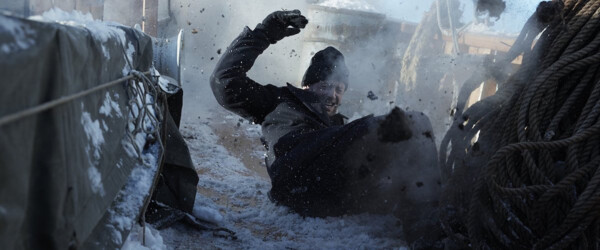
Image courtesy of IFC Midnight.
“The 12th Man” Starring Thomas Gullestad, Jonathan Rhys Meyers, Marie Blokhus and others. Directed by Harald Zwart. 135 minutes. Unrated. Hulu.
Del’s take
To describe a movie as “interesting” is to suggest it is not inspiring or intriguing or epic in its sweep. I think that’s a fair assessment of “The 12th Man,” an interesting movie that somehow falls short of the real events it seeks to depict.
Based on the 2001 book “Jan Baalsrud and Those Who Saved Him,” by Tore Haug and Astrid Karlsen, “The 12th Man” chronicles the action of a band of saboteurs who are captured trying to infiltrate German-occupied Norway during World War II. One man is shot on site, 10 are later executed, but a 12th man, Jan Baalsrud (Gullestad), escapes into the snowy wilderness. What follows is a harrowing tale of survival and near-misses as Baalsrud makes his way toward neutral Sweden while being pursued by obsessive Sturmbannführer Kurt Stage (Rhys Meyers).
“The 12th Man” is a testament to human strength and endurance. Baalsrud experiences gruesome deprivations during his months-long odyssey across the frozen landscape – he is shot, suffers hypothermia and frostbite, and starves while hiding from the relentless Stage. You wonder how a body could survive such abuse. For his pursuer, the stakes are equally painful. If Baalsrud succeeds in reaching Sweden, Stage’s failure will be noted in Berlin … with legendary Nazi displeasure.
The movie does a credible job of replaying the events of Baalsrud’s trek, which we are assured actually happened, with the exception of Stage’s pursuit. According to my research Stage did not pursue Baalsrud across frozen Norway. In fact, the Nazis believed Baalsrud drowned trying to swim across a fjord. Still, the major points of Baalsrud’s escape and the suffering he experienced remain intact and are, as I said, harrowing if not grotesque.
The movie is beautifully shot and makes effective use of the ice and snow as a kind of character unto itself, much the way snow and cold figured into the telling of “Let the Right One In.” I felt a sympathetic shiver as Baalsrud plunged into the chilly Arctic waters of a fjord as German soldiers and their dogs approached, or hid for days in the snow-covered swale of an icy boulder.
The stars of “The 12th Man” are not Baalsrud but the Norwegian people along the way who sacrificed all to facilitate his escape. It is they who risked everything to help a man they didn’t know, a patriot but a stranger who could not improve their lives under Nazi rule but could make things a hell of a lot worse if it became known they were harboring a fugitive.
The movie also reminds us the Nazis were evil, horrible men and women who did evil, horrible things to millions of innocent people. Given that fascism is on the ascendency and some of the former president’s more ardent and colorful admirers are fond of culling the Nazi playbook for political tips and strategies, maybe a stomach-turning dose of “The 12th Man” is just the tonic for this generation hell bent on re-discovering that tragic wheel of human misery.
My gripes with “The 12th Man” are, for starters, that it’s way too long. Two hours and 15 minutes of unrelenting tension is too much for an audience to endure. The movie also dwells to lurid excess on the details of Baalsrud’s suffering – I wanted to fast-forward through the scenes of blackened toes falling off or Baalsrud chipping his teeth through another bout of fjord-induced hypothermia.
My biggest complaint is that while the camera mostly focuses on Baalsrud, perhaps it should have been focused on the ordinary Norwegians who made his escape possible. Baalsrud does not do much except stay alive – no small thing, I admit. But it is the fishermen and trappers and villagers, the real stars of the movie I alluded to earlier, who take the action and pay the price for getting Baalsrud to Sweden. They will not have any movies made about them, but maybe they should.
Overall “The 12th Man” is a decent enough war movie about a real event. But it is too long, relishes a little too much the suffering of its protagonist and maybe doesn’t spend enough time detailing the heroics of its real heroes. Watch it on Hulu but gird yourself for a sometimes graphic marathon of pain and suffering.
Oh, and yes, it uses subtitles, if that’s an impediment for you.
I would grade it a B-.

Mladen’s take
Del and his people-are-wonderful-under-duress approach to reviewing a movie. Sheesh. Hey, Del, it was a stoolpigeon Norwegian who fingered the Norwegian commandos to the Germans. The indigenous stoolie was responsible for the deaths of the 11 saboteurs and our beloved Baalsrud’s prolonged exposure to the elements at high latitude as he fled east.
No, no. Let’s put the “The 12th Man” in context.
The film, though decent enough, is what I label “history revenge” cinematography. In Europe, the ongoing object of history revenge is Germany. Please, no misunderstandings. The Third Reich and its Hitler-driven National Socialism is among mankind’s most soulless societies. Tactically, however, the Wehrmacht right to the end of Word War II was one helluva fighting force and the Gestapo one helluva counter-spy and internal intelligence directorate. That’s what the “The 12th Man” is about. It tries to make the fact that one surviving Norwegian, who was a member of a raiding party that utterly failed to execute its mission and itself was executed, equaled a great victory for Norway against a country that occupied it from 1940 to 1945. What nonsense.
Europe today is far from the savage bundle of countries that colonized the globe and annihilated or oppressed cultures, ethnicities, languages, or sustainable economic systems from Africa to Asia to both Americas. The EU, the euro zone, and NATO have rendered Europe less blindingly feudal, fascistic, or mercantilist. But, all those countries that had their asses kicked by Germany between 1938 and 1945 still hold grudges.
“The 12th Man” is a manifestation of the history revenge grudge from the Norwegian perspective like 2013’s very good “Battle of Westerplatte” reflects Polish and Lithuanian history revenge. What would happen to you if you started taking about the history of Vichy France in Paris today? Your escargot would come laced with arsenic. Hell, the Russians, who obliterated Hitler’s Germany, still talk, write, sing, and make TV series and movies about the Great Patriotic War as though it happened yesterday.
We must never forget World War II, but we have to be careful of believing the way it’s portrayed in films, documentaries, fiction literature, and partisan interpretations of events. There were good guys and bad guys on the Allied and Axis sides, though some were worse than others. Norway had its share of Nazi sympathizers and straight-up fascist politicians. The continuum of World War II injustices must be understood and illuminated to withstand the diabolical revision of history that is easily spread through the internet and entertainment media.
Kicking aside my infallible law of history revenge as it applies to nationalistic re-interpretation of events long ago to look at the merits of “The 12th Man” without context, I give the film a C+.
It shouldn’t take you long to see that the movie’s producers and director (as well as the book on which the movie is based) tried to transform a lemon of a commando raid into lemonade even if you’re unaware of the geopolitics of World War II. Twelve men were sent to help the allies and one lived, an 8 percent rate of survival. What would have happened if only 8 percent of the Yanks, Tommys, and whatever the nickname for Canadian soldiers storming five beaches in 1944 Normandy lived? Uh huh. Also, most of the “The 12th Man” depicts Baalsrud trying to stay alive while running and hiding and hiding and running from Germans. He made no effort to continue the mission, explode Luftwaffe aerodromes, or stick around to use his training to help Norwegian resistance fighters.
Look, the saboteurs had balls, but in the movie as in real life, they had their balls shot off. One of them surviving with his balls intact, though a few of his toes on the right foot did not, was not a victory for Norway. It was a moment of triumph of the will for a very, very limited number of individuals. “The 12th Man” would have served better as a microcosm of a story showing us the determination and grit by the people we saw in the movie and got to know, rather than trying to convince me that their effort helped all of Norway and its millions of people endure occupation. A more disciplined, less holistic “The 12th Man” might have also allowed some 25 minutes to 30 minutes of the film to be cut.
“The 12th Man” is worth watching. The austere beauty of fjords, mountains, and snow near the Arctic circle is captured nicely in the film. There’s good acting. The women are all lookers. But, I’m no chump. There’s no way that one soldier surviving a busted mission improved life in a country overrun by a conquering army.
Mladen Rudman is a former journalist and technical writer. Del Stone Jr. is a former journalist and author.
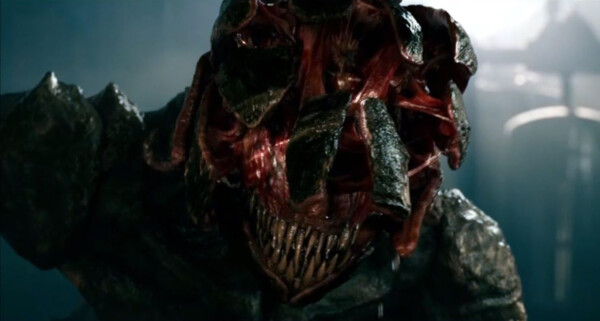
Image courtesy of Paramount.
“A Quiet Place” Starring Emily Blunt, John Krasinski, Millicent Simmonds and Noah Jupe. Directed by John Krasinski. 90 minutes. Rated PG-13.
Del’s take
“A Quiet Place” is relentlessly tense. To be honest, I was relieved when the movie ended because throughout, my stomach was cinched into a knot. It has a couple of problems, but overall it’s a good value for your entertainment dollar and I recommend it.
It’s directed by John Krasinski of “The Office” fame, but Emily Blunt, who plays his wife both on and offscreen, has been getting top billing. Krasinski also directed the film. I’ve always wondered how that works. If you screw up a scene, do you get mad and yell at yourself?
The story is about a family trying to survive the emergence of a blind super predator that hunts by sound. I was a little unclear as to where the predators came from. Are they extraterrestrials? Demons? Genetic mutations? I don’t think the movie made that clear, but reviewers are calling them aliens so I’ll go with that.
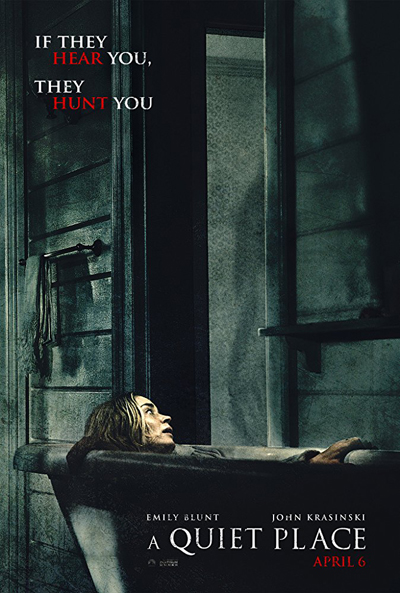
The Abbott family lives on an abandoned farm in the countryside, never speaking, never wearing shoes, never doing anything that might reveal their presence to the monsters. They communicate through sign language and scatter sand along their footpaths to muffle the sound of their tread.
The first anecdote of the movie ratchets up the tension to an unbearable level. The family is scavenging for supplies in a nearby town. Their youngest, a little boy named Beau, finds a battery-operated space shuttle toy and wants to play with it, but Krasinski takes it away from him and removes the batteries, explaining the toy is too loud. Later, Beau’s big sister Regan (Simmonds) gives him the toy, and as they’re leaving Beau grabs the batteries.
As they’re walking back to the farmhouse the boy falls behind – because he’s loading the batteries into the toy. When he turns it on it begins to emit loud sounds, and what you fear might happen … well … it actually happens.
Cut to a year later. Blunt is pregnant. Otherwise, nothing has changed. Well, not quite. Regan blames herself for her little brother’s death. She thinks her father hates her. She doesn’t feel welcome in the family, even after her dad tries to invent a turbocharged hearing aid that might repair her deafness. The Abbotts’ other son, Marcus (Jupe), is more terrified of the monsters than the rest of the family and doesn’t think his father will keep them safe. Turns out he should be afraid.
I won’t say anything more about the plot. I don’t want to spoil it for you. Suffice it to say everything that follows cranks up the tension to the point you will be breaking for the bathroom or snack bar just to get your heart back in sync, like I did during a certain scene involving a nail.
But yes, in my opinion the movie had a few problems. The story supposedly takes place between one and two years after the creatures arrive, yet the town the Abbotts raid for supplies looks like it’s been abandoned for many years. By the same token, the farm where they hide is surrounded by lovingly cultivated fields of corn, which could not have been accomplished without the use of heavy – and loud – machinery.
And what’s with this baby thing? Why would they bring a baby into this world? And aren’t babies loud? I mean, really, really loud?
If the monsters are attracted to sound, why couldn’t Krasinsky set up some speakers in the middle of that corn field, crank up the Iggy Pop and blast the monsters to smithereens when they show up?
Details, details.
Apart from those gripes, “A Quiet Place” is a super tense, super scary movie that should appeal to both fans and non-fans of horror. See it in a movie theater. Don’t wait for it to show up on Netflix or Prime.
While I’m at it, let me recommend the smartphone app MoviePass. You pay $7 a month for one theatrical release – per day. Thirty-one movies for $7? I don’t know how they make money at it, but somehow they must.
That’s how we got to see “A Quiet Place.”
I give it a B+.
Del Stone Jr. is a former journalist and author.

Image courtesy of Universal Pictures.
“Pacific Rim: Uprising” Starring John Boyega, Scott Eastwood and Cailee Spaeny. Directed by Steven S. DeKnight. 111 minutes. Rated PG-13.
Del’s take
I had great hopes for the original “Pacific Rim” and came away greatly disappointed, so my expectations of “Pacific Rim: Uprising” were minimal. But what the hell. It was a rainy Sunday afternoon and while I had a crap-ton of stuff that needed doing, I didn’t feel like doing any of it. “Uprising” it was.
And hey, guess what? It didn’t suck as bad as I thought it would. Let’s face it: You don’t go to a “Transformers” or “Pacific Rim” movie for the social commentary or existential angst. You go to see giant monsters and robots beat the shit out of each other, destroying cities in the process. In that meager capacity “Uprising” did not disappoint.
The movie stars John Boyega as Jake Pentecost, son of Idris Elba’s Stacker Pentecost from the original movie. Stacker was the marshal of the Jaeger corps, giant robots built to defend humanity from the Kaiju, equally giant monsters from another dimension that entered this world through a breach in the Pacific Ocean floor. Stacker is revered for his role in sealing the breach and saving the world.
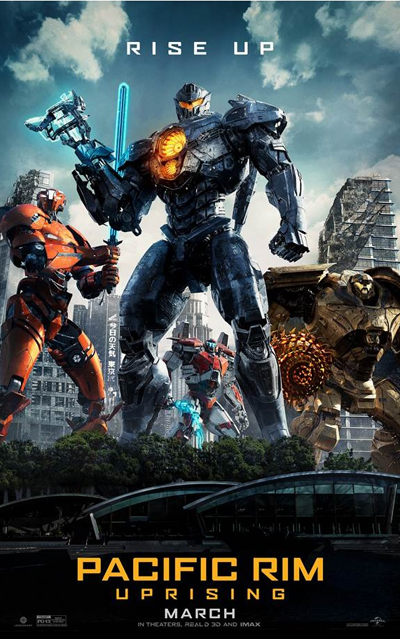
Jake, once a promising Jaeger pilot himself, has given up his career to become a petty criminal. During a theft gone wrong he meets young Amara Namani (Spaeny), who has built her own Jaeger called Scrapper. Because it is against the law to own unregistered Jaegers, Amara and Jake are hauled in by the authorities. Instead of being jailed they’re sent to the Jaeger corps, where Jake is to resume his old job and Amara becomes a cadet.
The Shao Corporation has a plan to replace Jaegers with huge, robotic drones, and I won’t say any more about that because it would spoil the movie for you. Suffice it to say “Uprising” becomes more action-oriented with the second act and continues through the third.
John Boyega does a good job with his role and shows he can act outside of “Star Wars.” He manages to bring a little more oomph to his role, which is saddled with clichés. I last saw Scott Eastwood in “The Fate of the Furious” and he was about as wooden as a ventriloquist’s dummy. His acting has improved and at times he seems almost human, so there’s hope. Spaeny is a natural for the screen. I think we’ll be seeing a lot of her in the future.
I think this movie was better written than the original. The dialogue was an improvement. It didn’t strike me as silly and fanboyish as del Torro’s script.
The flaws? I’m sure there were plenty. The premise itself is the biggest flaw of all. But I turned off that part of my brain before I walked into the theater. Again, you don’t watch a “Transformers” or “Pacific Rim” to appreciate the logic or scientific accuracy. The movie panders to a Chinese audience so if you have a problem with that, be prepared.
“Uprising” sets up a sequel, and I initially thought that wouldn’t happen until I checked the overseas grosses. Domestically it has earned just south of $60 million, with a budget of $150 million. But worldwide? A whopping $275 million for a $333 million cume, so I guess we can expect a “Pacific Rim: Domination.” Way to go, Chinese audience.
Don’t get me wrong: “Uprising” is an entertaining and even fun movie if your expectations aren’t too high. But don’t expect much in the way of depth.
I give it a B-.
Del Stone Jr. is a former journalist and author.
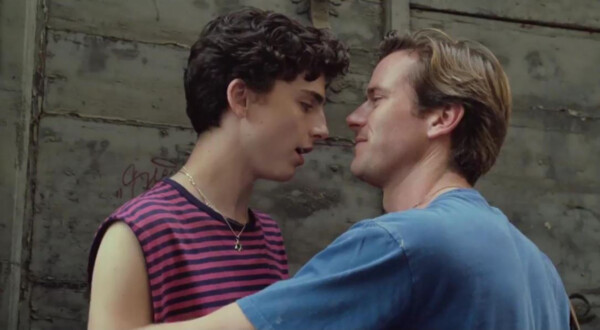
Image courtesy of Sony Pictures.
“Call Me By Your Name” Starring Timothee Chalamet, Armie Hammer, Michael Stuhlbarg, Amira Casar. Directed by Luca Guadagnino. 2 hours, 12 minutes. Rated R.
Del’s take
You’re lying on the beach. It is the first warm day of spring.
You feel the pressure of sunlight on your skin. The warmth is soaking into you, all the way to the bone, melting your body so that it flows into the sand. You’re smiling, and at first you don’t know why. But then you remember. Your hand slides across the beach towel until it encounters oily flesh. Is this a dream? Is it a fantasy? You squint against the brightness.
No. This is not a dream. Your smile broadens and you surrender yourself to the love of everything.
Watching “Call Me By Your Name,” Luca Guadignino’s romantic summer dream, is like lying on that mythical beach. It is warm and surreal and funny at times, unwinding at a languorous pace that matches its setting, a bucolic Italian countryside villa basking in the simplicity of 1983, before technology ruined our lives.
The movie is a near-faithful rendering of André Aciman’s acclaimed novel of the same name. Having read the book, I would say the movie is an improvement as it streamlines the story and does away with the viewpoint character’s neurotic internal monologues. Here we are left with soul stripped bare: a 17-year-old boy and his desire, both romantic and physical, for a 20-something grad student.
It has drawn some criticism in the States for depicting a sexual relationship with a minor. I won’t argue for or against such a thing, but it should be pointed out the age of consent in Italy, where CMBYN takes place, is 16.
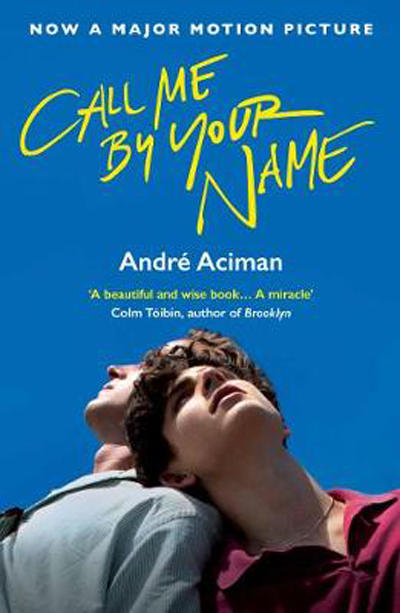
The story is about young Elio (Chalamet), who is staying with his college professor father (Stuhlberg) and mother (Casar) at their summer residence in Italy. Each year the good professor takes on a research assistant to help with him with his work. This summer’s arrival is the hunky Oliver (Hammer).
Elio is intrigued by the insouciant American, who dismisses him with a casual “Later” and seems to prefer the company of local young ladies or the poker-playing barflies of a nearby tavern. But all may not be as it seems. Is Oliver secretly interested in Elio? Should Elio give thought to his desires? The two begin a sometimes subtle, sometimes brutally obvious process of opening and closing the distance between themselves, like two heavenly bodies trapped in each other’s gravitational pull, until the inevitable collision takes place.
It is a sweetly choreographed dance between the two, set to the universal soundtrack of love and heartbreak that anybody, regardless of sexual orientation, can appreciate. We have all been there before. With luck, some of us will go there again. It makes life worth living.
Performances are spectacular. Stuhlbarg shines as Elio’s father, and saves his best moment for the waning minutes of the movie, where he delivers a searing monologue to his son that simultaneously crushes and inspires. To have a father like that.
Chalamet is dazzling as Elio. The media, in rhapsodizing about his performance, have declared that he is now a movie star. I rarely give credit to such excesses but in this case there is no excess. His performance is astounding.
Less impressive is Hammer as Oliver. Apart from his breakout performance in “The Social Network,” Hammer can’t seem to stop himself from bringing a certain doofiness to his roles. In CMBYN he tries not to do that, but throughout the movie, except during rare moments, he never seems comfortable in his skin and always on the verge of a joke or a mug for the camera.
The movie is smartly written and features a lush, verdant Italian countryside that functions as a controlling element of the story, much as the snow in the Swedish version of “Let the Right One In.” And despite the presence of so many Americans in the cast and creatives, the movie, thanks to Guadignino, presents itself as distinctly European in structure and tone.
CMBYN has been nominated for four Academy Awards, and I think it could win three – for best movie, best adapted work, and best song. Chalamet has been nominated for best actor but is up against the magnificent Gary Oldman, who is said to be mesmerizing in “Darkest Hour.”
That’s a shame, because Chalamet deserves recognition for his performance, as does Guadagnino for his direction. The movie is an emotional kick in the gut, one that elicits wild praise from its audiences, not to mention oceans of tears.
Much has been made about the final scene. I thought I was prepared for it, but I wasn’t. The vision of a defeated Elio, younger than his 17 years, slumped before an evening fire, a faint crackle in the background, his eyes glistening and his lips quivering while his mother and housekeeper, oblivious to his pain, set the dinner table in the background … and a mournful Sufjan Stevens quietly sings to us that “I have loved you for the last time … I have kissed you for the last time” … well, it is shattering.
I sat there, stunned.
And.
For the first time in all the years I have been watching movies, not one person in that theater – not one – left his seat until the credits had finished, the screen went dark, and there was nothing left to do but get up, go home and cry.
Grade: A.
Del Stone Jr. is a former journalist and author.

Image courtesy of Netflix.
“The Open House” Starring Dylan Minnette, Piercey Dalton and Sharif Atkins. Directed by Matt Angel and Suzanne Coote. 94 minutes. Rating not listed.
Del’s take
“The Open House” was pitched as a horror movie and I watched it because Netflix has been streaming decent non-theatrical programming lately (“Mindhunter” for instance).
Unfortunately, that isn’t the case here. While “The Open House” initially holds promise as a lite version of “The Shining,” it undergoes a slow collapse as it slides toward its dire conclusion, leaving the viewer to wonder what the point of all that was.
It’s hard to discuss the movie without spoiling it, so beware.
Suffice it to say young Logan Wallace (Minnette) is a promising track star living in what I presume to be the foothills of the Rocky Mountains – Colorado perhaps? – with his mom (Dalton) and dad (Aaron Abrams). All is not well in the Wallace household. Dad’s unemployment has stretched the family budget to the limit, and mom has tried, without success, to find a job herself. The rent is due and there’s no money to pay the bills. Meanwhile, Logan hopes to make the Olympics in track and field, something that may become possible if he continues to improve his times.
Logan and his dad venture to a convenience store for a carton of eggs and quart of milk. While Logan waits in the van, dad is mowed down in the parking lot by a driver suffering a medical event. It is all very sudden and heartbreaking, as Logan’s relationship with his father is one of the movie’s sparse warm spots. With the death, a bad situation has been rendered into a horrible situation.
After the funeral, Logan’s aunt offers to let them stay at her and her husband’s remote mountain house while they figure out what to do with their lives. Logan’s mother, aware of their dire financial straits, accepts the offer, much to Logan’s predictably selfish despair. In fact, he spends the rest of the movie pouting and blaming his mother for their sad turn of fortune.
The house is a McMansion with a spooky old basement that seems impervious to illumination. In fact, not once do Logan or his mother attempt to locate and replace a burned-out light bulb, meaning several trips into the crypt-like basement with a flashlight (and you know who temperamental flashlights are in horror movies) will be necessary after scary things start happening.
The townfolk comprise the usual suspects – the crazy, nosy neighbor; and the noble store clerk who might just have an interest in Logan’s mother (much to Logan’s irritation) and otherwise manages to show up at any number of weird, beyond-coincidental occasions, conjuring visions of stalkers.
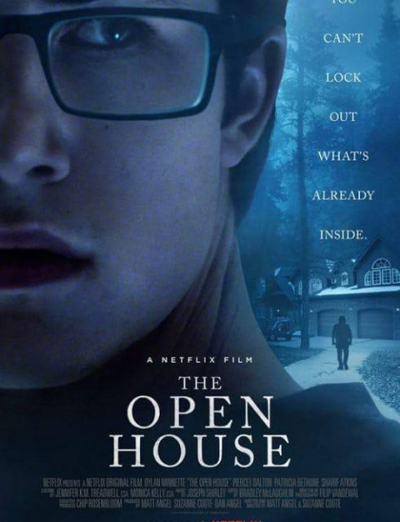
Meanwhile, weirdness escalates. The water heater keeps getting turned off. Logan’s glasses disappear, then reappear. Loud noises interrupt everybody’s sleep. Strange vehicles pull into the driveway, their headlights blinding, then abruptly leave. And nobody is looking for a job.
The house is for sale. Every Sunday between the hours of 11 a.m. and 5 p.m., Logan and his mother must leave for open house. The movie suggests that somebody, or something, arrived for one of these open houses and decided to stay.
Which is a shame, because the movie’s other tensions provide much more interesting potential – Logan having to set aside his dreams of the Olympics, the resentment he feels for his mother, and his mother’s resentment of her husband’s failure to provide for them. These are barely explored in favor of, well, dead-ends, red herrings, and an antagonist who seems to arrive from somewhere beyond the movie’s logical reach.
“The Open House” wraps with an absurd and pointlessly nihilistic series of events that remind me of films I saw in the 1970s, movies that sought to achieve emotional resonance by clubbing the viewer with cruelty and shock. That didn’t work then and it doesn’t work now.
Minnette is wooden and unsympathetic in his role as Logan, while Dalton manages to imbue her saddened wife and mother character with moments of real pathos. Both are saddled with a screenplay that, in the end, doesn’t make much sense.
It’s a nice-looking movie but I can’t recommend “The Open House.” If you subscribe to Netflix streaming and want to watch it, by all means do so. It will cost you only 94 minutes of your life.
I would grade this movie a generous C-, maybe a D+.
Del Stone Jr. is a former journalist and author.
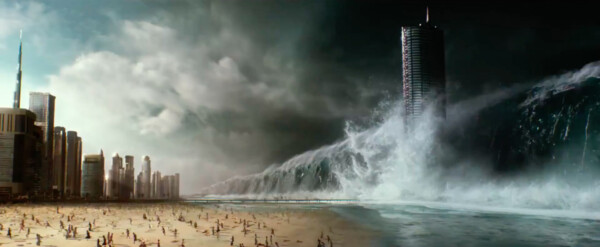
Image courtesy of Warner Bros.
“Geostorm” Starring Gerald Butler as Jake Lawson, Jim Sturgess as Max Lawson, Abbie Cornish as Sarah Wilson, Talitha Eliana Bateman as Hannah Lawson, Alexandra Maria Lara as Ute Fassbinder, and others. Directed by Dean Devlin. PG-13. 109 minutes. Streaming on Hulu.
Del’s take
Every now and then a movie comes along that makes me feel pretty good about my own creative efforts. “Geostorm” makes me feel like a goddamn genius.
“Geostorm” is dumb even by Mladen’s low standards, which lie somewhere between root cellar and hell. I can tell how much I hate a movie by the number of times I roll my eyes. By the end of “Geostorm” I needed Dramamine and one of those little fold-out paper bags the airline puts in your seat pocket. It’s that bad.
Which is weird because they spent a lot of money making the damn thing – $120 million – and got some decent actors – Andy Garcia, Abbie Cornish, Jim Sturgess and Ed Harris – Ed freaking Harris! who should have won an Oscar for “The Truman Show” and might be my favorite actor of all time. How could a movie with such great talent go so terribly wrong?
Reason No. 1: Gerard Butler.
Giving Gerard Butler the lead was a mistake. Don’t get me wrong. I like Mr. Butler. He’s a reliable disaster movie performer – check “Greenland” and “Angel has Fallen.” Unfortunately, he’s also one of those actors whose face falls out of memory faster than giant hailstones fall out of the sky over Tokyo. I had to consult my Old Fart’s Digital Crutch, Msgr. Google, for other movies he’s starred in. Not a good sign.
Reason No. 2: Dean Devlin.
“Geostorm” was directed by Mr. Devlin, a graduate of the Roland Emmerich school of disaster filmmaking – except in this case he forgot to study for the final. For a disaster movie, you see remarkably few disasters. What you do see is a clunky whodunit plot that did little to pique my interest. I assumed the bad guy was either (a) an evil corporation dissatisfied with trillion-dollar profit margins, or (b) a Republican. Either way, the who was less important to me than the what. Dammit, Jim, I want my disaster movies to show disasters, not be disasters.
Reason No. 3: Some seriously freaking tectonic logic flaws.
“Geostorm” is predicated on the idea that escalating weather disasters will lead to a gigantic, all-consuming “geostorm,” the meteorological equivalent of Donald Trump’s political and business “empire.” So all nations on Earth marshal their resources to build a gigantic hairnet-kinda thing in orbit that has the ability to nip weather disasters in the bud.
First, let me point out the words “climate change” are not, to my recollection, ever uttered in this movie, which makes me wonder why, given that escalating weather disasters are the hallmark of climate change. Also, the suggestion that all nations (a) recognize the problem and (b) agree to cooperate isn’t science fiction. It’s fantasy. It destroys my willingness to suspend disbelief.
Second, the giant hairnet thingy is just – freaking – impossible. And building it would cost a helluva lot more than doing the things that already cause the hairpieces of conservatives and Republicans to spontaneously combust, things like planting trees, developing more efficient batteries, or inventing a fusion reactor. Is “Geostorm” a disaster flick or “Lord of the Rings”?
Speaking of which, it wouldn’t be a disaster movie unless there was (a) an MIA father who’s feeling guilty about his absence, (b) a child who’s pissed-off because Daddy “wasn’t there,” and (c) an estranged relationship that can only be mended by tens of millions of people dying in a global conflagration.
Yup, that’s “Geostorm,” a melding of all the worst aspects of “2012,” “Independence Day,” “Twister,” and maybe even “The Towering Inferno” and “The Poseidon Adventure.” And to enhance your eye-rolling experience, it’s streaming on Hulu, which is the “Geostorm” of streaming services. I have never, ever streamed a movie on Hulu without something going wrong – the movie buffers, it locks up, the frame crashes and will not play, no matter how many times I clear my cache. I end up digging through my DVDs and watching it the old-fashioned way.
Movies like “Geostorm” are supposed to be dumb fun. Devlin forgot the “fun” part. I give it a D, and I don’t care how many insulting giant hailstones Mladen flings my way.

Mladen’s take
I like sci-fi that uses real-world happenings taking place on Earth to be plausible. So, when “Geostorm” showed moviegoers a low-orbit satellite mesh controlled by a space station that manipulates the planet’s weather to limit the impact of global warming, I was, like, this is silly. How could anyone, even a let-the-imagination-loose filmmaker, think that leashing the weather caused by Earth’s 4.2 billion cubic kilometers of atmosphere, 1.4 cubic km of ocean, and 510 million km of surface land area was doable as a realistic sci-fi movie?
Well, “Geostorm” writers and its director were much more on-target with their movie’s foundational theme than I figured. The October 2023 issue of Scientific American has a story titled, “A Stratospheric Gamble.” It covers some of the ways some scientists are hoping to alter Earth to lessen the impact of climate change. SRM (Solar Radiation Management), folks, is on its way. What is SRM? Injecting volcanic eruption-size quantities of sulfur dioxide into the atmosphere to bounce some sunlight back to space. Lab coat geeks and governments (including our own) are thinking seriously about using geoengineering technology on a PLANETARY scale to mitigate the climate crisis, which was caused by our transportation and power generation technologies. Same old story and a history lesson never learned. Using new technology to offset the dangerous side effects of old technology always fails long-term and it’s always the poor who suffer.
So, the “Geostorm” scenario ain’t so unrealistic as it seemed to me before I read the Sci Am piece. That fact, paradoxically, allowed me to enjoy the film, more or less. In “Geostorm” the weather control space station starts to malfunction, causing its weather-inducing satellites to go berserk. An Afghan village is frozen to death. A part of Hong Kong is blasted to bits by overheating natural gas infrastructure. Lawson (Butler), the principal architect of the space station and an imperfect brother and father, is sent back to his orbiting masterpiece to determine what the hell is going on. As human command and control of the space station and its satellites continues to deteriorate, so does the weather on Earth. Incessant, infrastructure-destroying lightning in Florida that, somehow, increases the value of Mar-a-Lago. OK, I made up the part about Mar-a-Lago. A tsunami flooding one of the Persian Gulf’s fascist states. A flock of tornadoes here and hail the size of Thanksgiving turkeys there.
Del, and his combustible grudges, be damned. It’s a wonder he didn’t mention how the female commander of the space station becomes a weakling leader when Lawson embarks to save the day. Look, I agree with Del that “Geostorm” is maudlin and too much political thriller troupe. But, he should’ve been paying attention to the portrayed weather disasters. Del, start digging that bunker, fill it with canned goods, and make sure it has a helluva water pump to keep it dry because a geostorm is on the way, though it’ll come with a much less dramatic name – solar radiation management. And, rather than stocking the bunker with Dramamine, I suggest Xanax to help you with anger management.
Del contends “Geostorm” is bad crap. Ignore him. The film is good crap.
Mladen Rudman is a former newspaper reporter and technical writer. Del Stone Jr. is a former journalist and writer.
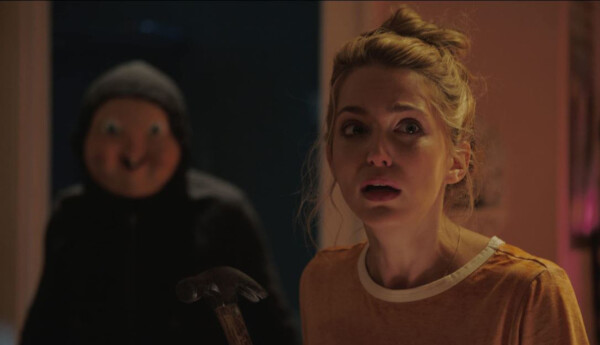
Image courtesy of Universal Pictures.
“Happy Death Day” Starring Jessica Rothe, Israel Broussard, Ruby Modine, Charles Aitken and Laura Clifton. Directed by Christopher Landon. 96 minutes. Rated PG-13.
Del’s take
I’m not going to say it … I’m not going to say it. …
Oh hell, who am I kidding? Of course I’m going to say “Groundhog Day” with a killer.
That’s the conceit of “Happy Death Day,” an entertaining trifle of a horror slash comedy (Yes!) that has come to a theater near you. Just in time for trick-or-treat, “Death Day” neither scares, edifies, nor elevates the spirit. What it does do is entertain with humor, mild romance and a who-dunnit that will defy your attempts to finger the killer.
The story goes like this: It’s Tree Gelbman’s (Rothe) birthday, but even Tree isn’t celebrating. She’s a beta beeyotch sorority snob who treats people as if they were disposable, except for her yummy college professor, Dr. Gregory Butler (Aitken), with whom she’s having an affair. She awakens in a dorm room (to her shame) with a ferocious hangover and finds she cannot remember what she did last night, especially as per young Carter Davis (Broussard) whose bed she currently inhabits. Carter is below her station in the college caste and she hustles out of his dorm lest one of her sorority sisters tumbles onto her indiscretion.
That night, on her way to a party, Tree encounters the killer, an individual wearing a pig baby mask who chases her across the campus and eventually stabs her to death. Tree jolts awake in Carter’s bed, as she did that morning, and the day begins to anew, unspooling exactly as it did before, perhaps with a change of viewpoints for the audience’s sake.
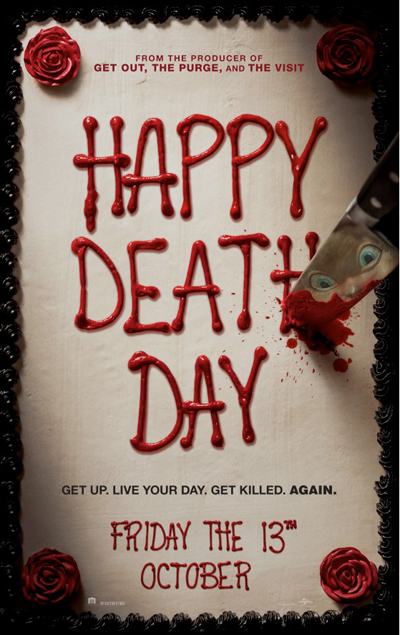
As the movie goes on we learn Tree will continue to relive the day, over and over, until the killer is dispatched. Problem is, her every attempt to kill the killer ends with her own death – by gunshot, baseball bat, hanging, bus collision, even fire. Does the obnoxious Tree deserve to live? Will she figure out a way to destroy her nemesis before dying herself?
Interestingly, each iteration of her life gives Tree a chance to see what a terrible person she has become. As the callow but earnest young Carter observes, it’s never too late to change. And change is what Tree does, so that by movie’s end you may actually like her, assuming she lives long enough for that to happen.
At roughly an hour and a half, “Death Day” is shorter than a lot of current movies such as “Blade Runner 2049,” which clocks in at almost double the length. The movie moves along at a brisk pace and you’ll be kept awake by the snappy dialogue, daily variations in Tree’s manifestations, and the puzzle over the killer’s identity (Hint: Tree is an equal opportunity snob. It could be anybody on campus.). You won’t be put off by blood because there is hardly a drop.
I was unfamiliar with the cast, but everybody turns in a creditable performance, including director Landon. “Death Day” was written by Scott Lobdell, who is primarily a comic book writer.
Somebody at Blumhouse must be licking his chops. Costing a mere $4.8 million to produce, “Death Day” has earned $40 million plus as of week 2. It will likely top out at over $50 million earning a tidy profit for the Blumhouse horror meisters. Expect it to appear on DVD and streaming in the not too distant future, joining a fraternity – or in this case sorority – of young adult-themed slasher movies that provide a forgettable hour and a half of entertainment value then recede into the cinema background.
Go see it at the movie theater, because all movies deserve to be seen on the big screen.
I give it a score of B+.
Del Stone Jr. is a former journalist and author.
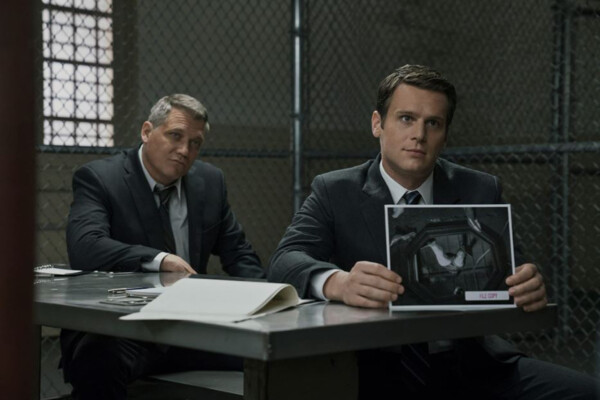
Image courtesy of Netflix.
“Mindhunter” Starring Jonathan Groff, Holt McCallany, Hannah Gross and Anna Torv. Creator Joe Penhall. 10 one-hour episodes. Rated TV-MA. Netflix
Del’s take
Stephen King gave “Mindhunter” his seal of approval and Entertainment Weekly graded it at A-.
Me? I’m not so sure.
Season 1 of this Netflix original series features 10 one-hour episodes of fascinating detective work and nifty nostalgic music, cars and fashions from the late 1970s. It’s a good show; I’ll definitely check out Season 2. But is it a terrific show? That remains to be seen. In my opinion, it has a couple of problems that for now are keeping it from becoming the next “Breaking Bad.”
“Mindhunter” stars Jonathan Groff as rookie FBI agent Holden Ford, a callow young man who is new to the wiles of women and criminals. He yearns to get inside the brains of notorious killers, as he believes by questioning these men – and invariably they are men – he can find commonalities in their destructive behavior that may help predict who might be the next Charles Manson.
He is approached by fellow agent Bill Tench, an instructor who belongs to the bureau’s Behavorial Unit. Tench convinces Ford to join him in “road school,” a program by which a bureau operative visits police departments around the country, teaching investigators the latest in FBI criminal behavior theory.
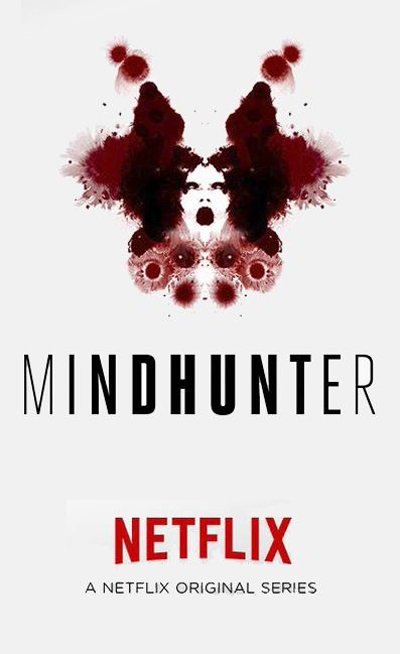
Ford soon realizes his road school excursions allow him a unique opportunity – to visit nearby prisons warehousing notorious mass killers and interview them. He convinces Tench to go along and soon, the two are assembling a loose dataset of serial killer behavior.
Simultaneously, investigators with the police departments ask Tench and Ford’s help in solving local murders. Ford applies what he has learned from his insidious interview subjects and tries to solve the crimes with a skeptical and reluctant Tench in tow.
They are joined by a college professor (Torv) who tries to apply discipline to their information gathering techniques and collation. While all of this is being done under the presumptive purview of the agency, Tench and Ford’s boss back at Quantico, gruff Unit Chief Sheppard (Cotter Smith) in fact doesn’t know a damn thing about that’s happening. When he finds out he wants to pull the plug, but word gets out and grant money flows in, legitimizing Ford’s quest to hunt the minds of mass murderers.
Therein lies a new and dangerous problem. Can the wide-eyed, innocent Ford probe the depths of murderous insanity without becoming insane himself?
“Mindhunter” contains the DNA of both “Silence of the Lambs” and “The X-Files,” more the latter than former. Sure, they’re all about FBI agents solving mysteries. But it they all have the same look and feel, an institutional starched shirtiness if you will. Violence and gore are restrained, although the language is incredibly salty, including the C-word. And the things they talk about – whew! Suffice it to say this is not a show for children. Oh, and there’s a bit of sex, too. It seems young Mr. Ford is still working on his, shall we say, oral exams.
McCallany is sensational as the entrenched, dogmatic Tench. It is only when the camera focuses on his home life that he seems less than sure-footed, perhaps by design. Speaking of which, things are rocky at home, with an adopted child who shies away from him and won’t speak, to a wife contemplating divorce.
Ford’s girlfriend Debbie is smart, quick-witted, sardonically hilarious and played to perfection by Gross. Torv’s professor, Dr. Wendy Carr, is icily detached. She reveals only isolated glimpses of humanity – feeding an unseen cat in the laundry room of her apartment complex, or becoming enraged with Tench and snarling, “Fuck you, Bill.” If looks could kill, she would be a ninja assassin.
Then there’s Groff’s rendition of Ford. In the first few episodes he is portrayed as innocent and trusting. Surely this blank mold of a man could not emerge from the company of serial killers without somehow being shaped by them.
Suffice it to say by Episode 10 Ford has changed, and the transformation is dramatic. That’s one of the problems I have with “Mindhunter.” Ford’s evolution is hasty and to a large extent without foreshadowing. Along about Episode 7 I was asking myself, “What happened to him?”
And a nitpick if you will: Tench and Ford’s crime-solving abilities seem a tad suspect. In every case it is the local investigators who point them in the direction of the eventual suspect. Their role becomes one of tricking that person into confessing to the crime, which itself becomes a plot point and, I suppose, a device to symbolize the moral and ethical alchemy taking place within Ford.
Still, “Mindhunters” is a good series and well worth a watch. I expect its positive reception will result in a new season, and I’ll be interested to see where it goes.
One last kudo: Cameron Britton, who plays mass murderer Edmund Kemper, steals every scene he’s in. I could see a limited series constructed around him.
I grade “Mindhunter” a B.
Del Stone Jr. is a former journalist and author.
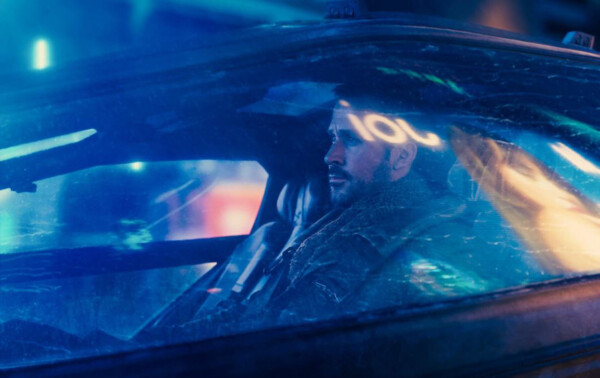
Image courtesy of Warner Brothers.
“Blade Runner 2049” Starring Ryan Gosling, Harrison Ford, Robin Wright and Sylvia Hoeks. Directed by Dennis Villeneuve. 2 hours, 44 minutes. Rated R.
Del’s take
As I purchased my ticket for “Blade Runner 2049” the ticket taker said, “It’s entirely possible you will be the only person in the theater.”
He was almost right.
Initially I was the only person in the theater. I frantically texted my movie-going crony, Dusty. “Please hurry. I am the only one in the theater. It’s creepy.”
By the time the movie started there were 13 other individuals with us, not an auspicious showing for a much-ballyhooed sequel to a movie legend.
The original “Blade Runner” didn’t do much at the box office, pulling in a little over $32 million domestically over its lifetime. “2049” seems headed to a similar fate. The film has so far grossed $60 million and may never earn back its $155-plus million expenses.
That’s too bad because it’s a worthy successor to the original Ridley Scott classic, despite the fact that audiences don’t seem to care.
I suspect “2049’s” major problem is that contemporary moviegoers are too lazy to enjoy a movie that builds its tension slowly and requires audiences to think. Why should audiences think when they can coast along in a state of lobotomy-like bliss, voting for Donald Trump and watching crap like the upcoming “Geo Storm”?
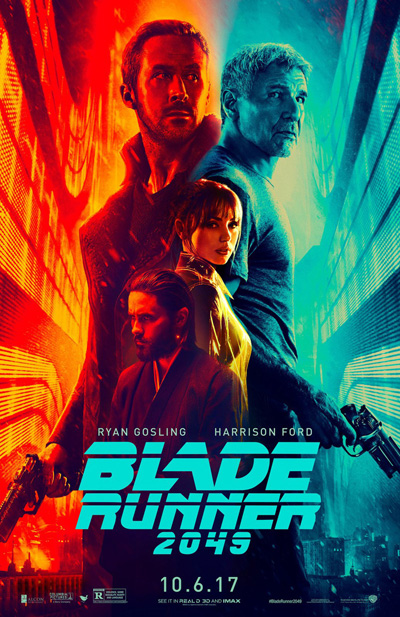
In “2049” Ryan Gosling is Officer K, a replicant hunter who belongs to a new generation of the genetically engineered lifeforms himself, compliant slaves who do what they are told. When he is ordered to investigate a possible older-generation replicant hiding in the environmental wasteland that Southern California has become, he tumbles onto a larger mystery that promises to “break the world,” as Lieutenant Joshi (Wright) puts it.
What follows is a journey across the hellscape of Los Angeles and beyond in search of the truth, which eventually leads K to Deckard (Ford) and a confrontation with agents of the Wallace Corporation, manufacturer of the new, compliant replicants. Wallace is headed by the cool-handed Neander Wallace (Leto), who is looking for a way to make replicants faster. Does K hold the solution to that problem?
“2049” is a replicant itself, duplicating the mood and pacing of the original “Blade Runner.” The score evokes the original Tangerine Dream soundtrack yet diverges in strange and interesting ways. The noir ingredients are still there – endless rain, sometimes interrupted by snow. Neon signs with gigantic holograms confronting pedestrians about their shopping choices. Retro technology and clothing styles. At any moment I expected to see Daryl Hannah back-handspringing into the fray.
Gosling measures up to Ford’s original performance, offering the same world-weary yet hopeful emotional resonance to the possibility that maybe, just maybe, there is more to his manufactured life than even his makers were aware of. His exchanges with his holographic lover Joi (Anna de Armas) are simultaneously touching and heartbreaking. To know that these two artificial entities – one grown in a vat, the other digital – constitute all that is good about this world damns the future with sadness and futility.
The movie is long, almost three hours, and therein lies its flaw. The pacing is glacial – not the post global warming “glacial” of retreat, but the inch-a-year growth of ice before mankind dumped his pollution and greenhouse gases into the atmosphere. At times director Villeneuve seems to love his creation so madly he dwells on unimportant details, unwilling to slay his darlings as it were. It feels every bit as much as a three-hour movie.
Still, it’s three hours of arresting visuals, soaring music, and tantalizing questions: Who else might be a replicant? Will these new replicants throw off their designed constraints and launch a revolution? How will mankind survive without its slave labor force?
Fans of the original should catch “2049” in a movie theater to enjoy its visuals in their native habitat. Newcomers should probably watch the 1982 original before venturing to the theater.
Watch it now, because if “2049” doesn’t start making money soon, it may be another 35 years before we see Part 3.
Del Stone Jr. is a former journalist and author.